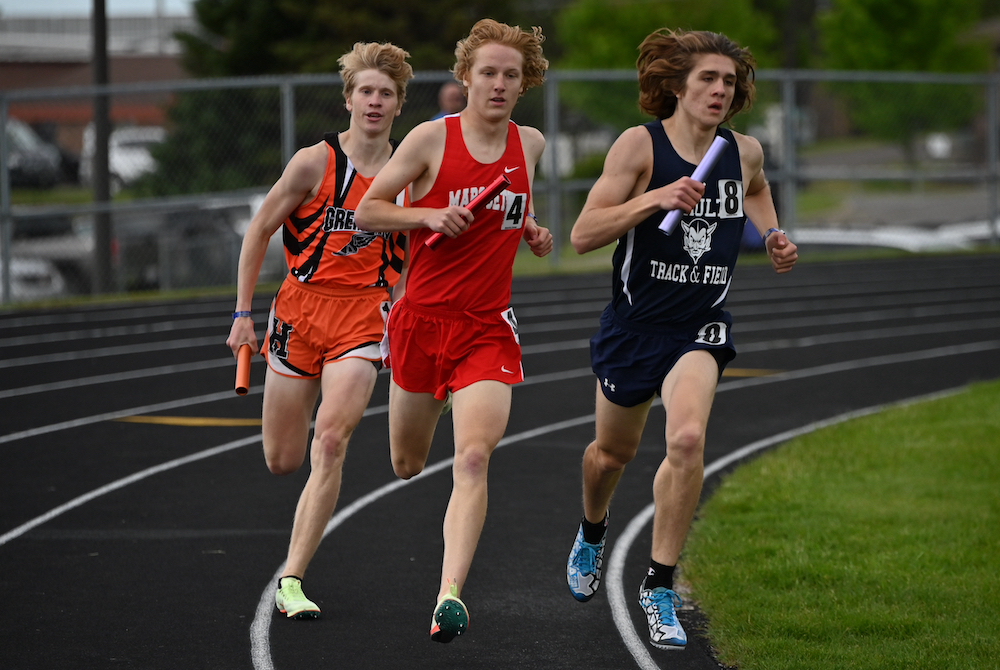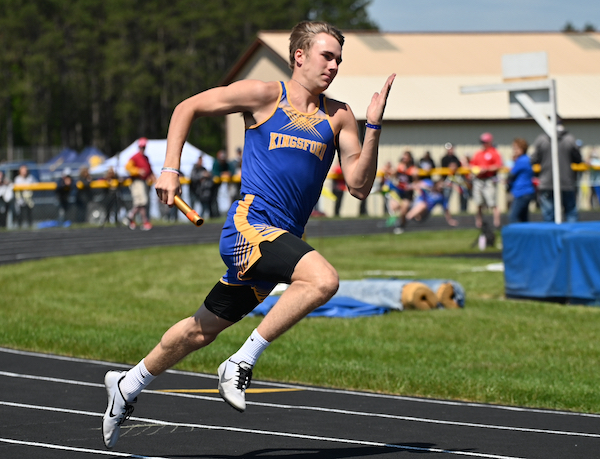
Marquette Holds Off Charging Kingsford for 1-Point Finals Victory
By
John Vrancic
Special for MHSAA.com
June 5, 2022
KINGSFORD — The Marquette boys retained their Upper Peninsula Division 1 track & field championship here Saturday, as they squeezed past the Kingsford Flivvers 138-137.
The Houghton Gremlins placed third with 56 points.
Marquette held a three-point lead heading into the day’s final race, the 1,600-meter relay.
Kingsford won it in 3 minutes, 35.29 seconds, but Marquette secured the team title by placing second (3:36.01).
Marquette junior Carson VanderSchaaf set a UPD1 record in the 3,200 at 9:46.53 seconds, shaving more than three seconds off the old mark (9:50.03) by Lance Rambo of Marquette in 2015.
VanderSchaaf also took the 1,600 (4:23.45), followed by his twin brother Colin (4:28.46) for Marquette, which also won the 3,200 relay (8:32.36) on a sunny and warm day at Flivver Field.
Colin VanderSchaaf later took the 800 (2:00.79). He was followed by Houghton senior Eric Weiss (2:03.18) and teammate Cullen Papin (2:03.77).
 Weiss was also runner-up in the 3,200 (10:07.12) and third in the 1,600 (4:37.2).
Weiss was also runner-up in the 3,200 (10:07.12) and third in the 1,600 (4:37.2).
Cayden Dahlen provided Marquette with a first in discus (139-8), and Sam Markey captured the 110 hurdles (16.64)
Kingsford showed its depth in the sprints with Michael Floriano taking second in the 100 (11.51), followed by Diego Przeslakowski (11.67) and Cardel Morton (11.81).
Floriano then won the 200 (23.12), edging teammate Trestan Larson by two hundredths of a second.
Przeslakowski added a first in the 300 hurdles (40.76), and the Flivvers took the 400 relay (44.2) and 800 (1:33.22).
Kingsford’s Lucas Tappy won shot put (47-1) and Cole Myllyla gained top honors in long jump at 20 feet, 2¾ inches with Marquette’s Tyranon Dahlin runner-up at 20-1¼.
Calumet’s Dryden Nelson captured the 100 (11.37) and placed third in the 200 (23.39), and Houghton’s Cade Holombo took the 400 (51.39), edging Morton by one tenth of a second.
Menominee senior Brady Schultz retained his high jump title at 6-7 after also setting the meet and his school’s record at 6-8 at last year’s UPD1 Finals.
Schultz added an inch this spring to his former school record leap, soaring 6-9 at the Marinette, Wis., Invitational on May 9.
Ishpeming Westwood had an individual champion in pole vault as Lenny Pizziola jumped 12 feet to edge Sault Ste. Marie’s Jackson Gervasio by six inches.
Marquette's Jim Bennett and Sault Ste. Marie's Johnny Osborn competed in the first-time adaptive races. Bennett won the 100 (24.31), 200 (47.52) and 400 (1:39.74), and also competed in shot put (13-4).
PHOTOS: (Top) On the second corner of the final lap of the 3,200 relay, Houghton's Eric Weiss, Marquette's Carson VanderSchaaf, and Sault Ste. Marie's Jonathan Willis are neck-in-neck. Marquette's VanderSchaaf was able to hold off Houghton's Weiss for second place, and Sault Ste. Marie's Willis took third. Other members of the winning Marquette team were James Kraeg, Adam White, and Braden Ketzenberger. (Middle) Kingsford's Trestan Larson starts the winning 800 relay. Teammates included Brody Kopp, Michael Meneguzzo, and Diego Przeslakowski. (Click for more from Cara Kamps/Run Michigan.)

Track Gaining Speed Toward Future with Electronic Starting Devices
By
Steve Vedder
Special for MHSAA.com
May 23, 2023
Aubrey Greenfield thinks it might be the perfect time to reevaluate 130 years of tradition.
For a number of reasons, from technical to personal, the Oxford senior sprinter believes it makes sense for the crack of a starting pistol to be eliminated from high school track meets.
Because track meets would benefit in various ways from lowering costs to easier setup at meets to the human factor of competitors not having to flinch at the crack of a pistol shot, Greenfield believes the sport has a chance to embrace new technology – electronic starting devices (ESD).
In essence, an ESD replaces the starting pistol with a light flash, tone sound or both to begin a race.
"High school sports should put the athlete first," Greenfield said. "We should promote sports, and eliminating starting pistols promotes health in terms of PTSD or trauma for athletes and spectators and that would be good. I would like to think people would say that's a good idea."
In fact, Greenfield would go as far as to say if there was not an implementation of electronic starting devices, many of her teammates would have considered giving up the sport.
"If it's something that helps us compete safely, we're all for it," she said.
Greenfield's opinion apparently is spreading. Michigan High School Athletic Association senior assistant director Cody Inglis said the use of ESD makes it both affordable for meet starters and sensible for athletes and fans to rethink the use of starting pistols. While the MHSAA is not mandating electronic starting devices, it does promote the use of what Inglis calls "emerging technology." He notes that ESD are becoming the norm for organizations such as USA Track & Field, the NCAA and an increasing number of high schools.
 "I think we have to embrace new technology, and we think this will be something that takes hold," Inglis said.
"I think we have to embrace new technology, and we think this will be something that takes hold," Inglis said.
A key part of embracing ESD is the human element. The tragic Oxford High School shooting Nov. 30, 2021, that took the lives of four students while injuring seven others should not be relived even for a fleeting instance at a high school sporting event. Oxford athletic director Tony DeMare said the school began using ESD at every meet, including the MHSAA Lower Peninsula Division 1 Finals last June. He said that decision was embraced by virtually all schools Oxford encountered.
"We were very convinced that the alternative (of ESD) would promote a healthy attitude," DeMare said. "We were overwhelmed with the positive response. If a school was on the fence about it or might not be for it, I think we've started to see the tide turn in favor of people willing to listen and learn about electronic starting devices."
Inglis said the MHSAA is acutely aware of what the crack of a starting pistol can mean to athletes and fans.
"It's unimaginable what Oxford went through, and this is a small way we can help," he said. "We look at a (starting pistol) and think, ‘Could we do something else?’ It's a way of helping to solve a problem."
Over the last several years, the MHSAA has embraced finding an alternative to starting pistols. Inglis noted the discussion started with the cost and diminishing availability of 32-caliber ammunition that meet starters use. A box of ammunition, if it can be found, is around $75 a box.
In addition to cost, there is potential damage from excessive exposure to 150-plus decibels of sound generated by the traditional 32-caliber blanks. Medical studies show damage to ears caused by decibel levels above 120 dB.
The tragedy at Oxford accelerated the conversation.
Inglis said the cost of ESD can be likened to a school sinking money into artificial surfaces at football fields. Yes, there is a great cost at first, but over time money is ultimately saved. An ESD system itself ranges between $200 and $500. Speakers also may need to be purchased, but with ESD starting events like the 800 and 1,600-meter relays positioned near the outside lanes 8, 7, 6 and 5 would result in improved hearing by athletes at the start of a race.
There is one challenge with ESD that track administrators are working to overcome – lighting conditions that lessen the ability to see the ESD’s LED light or strobe when the button is pressed by a starter to begin a race. But that vision difficulty resulting from clear blue skies and backgrounds of setting suns can be substantially improved by incorporating a black background with an ESD – something as simple as a starter holding up black cardboard behind the lighting mechanism at the start of an event.
Inglis said when all factors are considered, the use of ESD makes sense.
 "With the climate we live in nowadays, no lookalike guns is good," he said. "We're not mandating this. But people are saying this is affordable."
"With the climate we live in nowadays, no lookalike guns is good," he said. "We're not mandating this. But people are saying this is affordable."
While switching to ESD would break 130 years of tradition, the timing could be a step forward, said Jeff Hollobaugh, co-author of the book "The Fleet Feet of Spring: Michigan's High School State Championships in Track & Field." He said while no definitive answer is possible, it's likely starting pistols were used at the inaugural state meet at the Jackson Fairgounds in 1895. The meet, which included events like tossing a 16-pound shot put, bike races and a 100-meter sprint, was sponsored by the Michigan Interscholastic Athletic Association (a predecessor to the MHSAA) and comprised mostly of the state's larger schools.
Hollobaugh's sentiments echo what many involved in today's high school track & field believe in terms of making a transition from starting pistols to electronic starting devices.
"It's a change, not necessarily good or bad, just different," he said. "It's not a drastic change, but it will take some getting used to. But it is the future. In the end, we'll all be fine."
DeMare believes the future of high school track will definitely include ESD.
"Our desire is that the practicality and sensibility of this will overcome the alternative," he said. "I think we'll see the automation and electronics taking hold of certain elements in track, and people will embrace it."
PHOTOS (Top) Runners watch official Bertha Smiley as they prepare to begin a race during last season's Lower Peninsula Division 1 Finals at Rockford. (Middle) An electronic starting device provided by VS Athletics was used to start those races. (Below) Smiley sets to begin an event. (Photos provided by David Kuderka/VS Athletics.)

